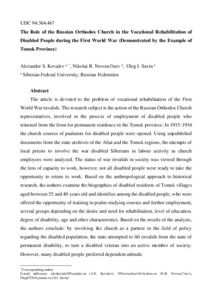THE ROLE OF THE RUSSIAN ORTHODOX CHURCH IN THE VOCATIONAL REHABILITATION OF DISABLED PEOPLE DURING THE FIRST WORLD WAR (DEMONSTRATED BY THE EXAMPLE OF TOMSK PROVINCE)
Скачать файл:
URI (для ссылок/цитирований):
http://ejournal52.com/journals_n/1527781374.pdfhttps://elib.sfu-kras.ru/handle/2311/111447
Автор:
Ковалев, Александр
Iновосельцев, Николай
Савин, Олег
Коллективный автор:
Гуманитарный институт
Кафедра истории России
Дата:
2018-06Журнал:
Bylye GodyКвартиль журнала в Scopus:
Q2Квартиль журнала в Web of Science:
без квартиляБиблиографическое описание:
Ковалев, Александр. THE ROLE OF THE RUSSIAN ORTHODOX CHURCH IN THE VOCATIONAL REHABILITATION OF DISABLED PEOPLE DURING THE FIRST WORLD WAR (DEMONSTRATED BY THE EXAMPLE OF TOMSK PROVINCE) [Текст] / Александр Ковалев, Николай Iновосельцев, Олег Савин // Bylye Gody. — 2018. — Т. 48 (№ 2). — С. 828-838Аннотация:
The article is devoted to the problem of vocational rehabilitation of the First World War invalids. The research subject is the action of the Russian Orthodox Church representatives, involved in the process of employment of disabled people who returned from the front for permanent residence in the Tomsk province. In 1915-1916 the church courses of psalmists for disabled people were opened. Using unpublished documents from the state archives of the Altai and the Tomsk regions, the attempts of local priests to involve the war disabled Siberians in labour activity as church employees were analyzed. The status of war invalids in society was viewed through the lens of capacity to work, however, not all disabled people were ready to take the opportunity to return to work. Based on the anthropological approach to historical research, the authors examine the biographies of disabled residents of Tomsk villages aged between 25 and 40 years old and identifies among the disabled people, who were offered the opportunity of training in psalm-studying courses and further employment, several groups depending on the desire and need for rehabilitation, level of education, degree of disability, age and other characteristics. Based on the results of the analysis, the authors conclude: by involving the church as a partner in the field of policy regarding the disabled population, the state attempted to lift invalids from the state of permanent disability, to turn a disabled veteran into an active member of society. However, many disabled people preferred dependent attitude.

